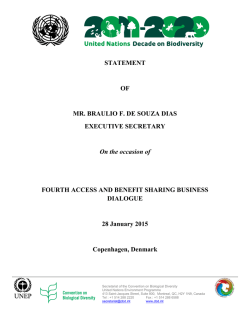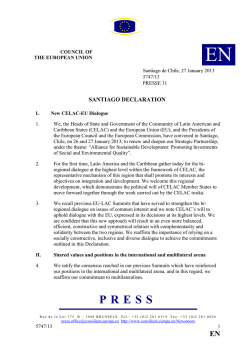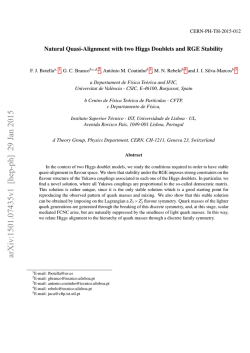
Linguistics fit for dialogue - Edinburgh Research Explorer
Edinburgh Research Explorer Linguistics fit for dialogue Citation for published version: Garrod, S & Pickering, MJ 2003, 'Linguistics fit for dialogue' Behavioral and Brain Sciences, vol 26, no. 6, pp. 678., 10.1017/S0140525X03330158 Digital Object Identifier (DOI): 10.1017/S0140525X03330158 Link: Link to publication record in Edinburgh Research Explorer Document Version: Publisher final version (usually the publisher pdf) Published In: Behavioral and Brain Sciences Publisher Rights Statement: © Garrod, S., & Pickering, M. J. (2003). Linguistics fit for dialogue. Behavioral and Brain Sciences, 26(6), 678 doi: 10.1017/S0140525X03330158 General rights Copyright for the publications made accessible via the Edinburgh Research Explorer is retained by the author(s) and / or other copyright owners and it is a condition of accessing these publications that users recognise and abide by the legal requirements associated with these rights. Take down policy The University of Edinburgh has made every reasonable effort to ensure that Edinburgh Research Explorer content complies with UK legislation. If you believe that the public display of this file breaches copyright please contact [email protected] providing details, and we will remove access to the work immediately and investigate your claim. Download date: 06. Feb. 2015 Commentary/Jackendoff: Précis of Foundations of Language: Brain, Meaning, Grammar, Evolution these semantic representations independently of the syntax and then have the problem of relating the two independent representations. Linguistics fit for dialogue Simon Garroda and Martin J. Pickeringb aDepartment of Psychology, University of Glasgow, Glasgow G12 8QT, United Kingdom; bDepartment of Psychology, University of Edinburgh, Edinburgh EH8 9JZ, United Kingdom. [email protected] [email protected] http://www.psy.gla.ac.uk/~simon/ http://www.psy.ed.ac.uk/Staff/academics.html#pickeringmartin Abstract: Foundations of Language ( Jackendoff 2002) sets out to reconcile generative accounts of language structure with psychological accounts of language processing. We argue that Jackendoff ’s “parallel architecture” is a particularly appropriate linguistic framework for the interactive alignment account of dialogue processing. It offers a helpful definition of linguistic levels of representation, it gives an interesting account of routine expressions, and it supports radical incrementality in processing. It is easy to argue that dialogue is the basic setting for language use (Clark 1996). Yet historically, generative linguistics has developed theories of isolated, decontextualized sentences that are used in texts or speeches, in other words, in monologue. In turn, this failure to address dialogue at a linguistic level is one of the main reasons why psycholinguistics have also ignored dialogue. In contrast, Pickering and Garrod (in press) propose a specific mechanistic account of language processing in dialogue, called the interactive alignment model. This account assumes that in dialogue, interlocutors align their linguistic representations at many levels through a largely automatic process. It also assumes that alignment at one level can promote alignment at other levels. This explains why coming to a mutual understanding in dialogue is generally much easier than interpreting or producing utterances in monologue. In this commentary we consider how Jackendoff’s framework in Foundations relates to this account. Jackendoff considers how linguistic theory can elucidate language processing (Ch. 7), a surprisingly fresh approach from a generative linguist. However, he does not explicitly consider how his “parallel architecture” might relate to language processing in dialogue. Here, we argue that the architecture turns out to be particularly helpful in understanding how interactive alignment comes about. First, it is consistent with multiple independent levels of representation with links between the levels. Second, it offers interesting insights into the linguistic representation of semifixed or routine expressions such as idioms, which we argue play an important role in dialogue processing. Finally, it is consistent with incrementality in both production and comprehension, which appears necessary for understanding dialogue. Independent levels and the interfaces between them. Jackendoff assumes that phonological, syntactic, and semantic formation rules generate phonological, syntactic, and semantic structures respectively, and these are brought into correspondence by interface rules, which encode the relationship between different systems (Ch. 5). This produces an architecture which is “logically non-directional” and hence not inherently biased toward either perception or production (Ch. 7, p. 198). These two general features of Jackendoff ’s account make it especially attractive as a linguistic framework for interactive alignment. First, interlocutors can align representations at different linguistic levels (e.g., Branigan et al. 2000; Garrod & Anderson 1987). These researchers argue that the alignment process is largely automatic (operating through so-called alignment channels) and that alignment at one level (e.g., the syntactic) reinforces alignment at other levels (e.g., the semantic) (e.g., Cleland & Pickering 2003). Hence, alignment channels can affect the application of the formation rules, and interface rules are encoded in the links between the levels. It would be difficult to find such a correspondence with traditional generative approaches where only syntax is generative and where 678 BEHAVIORAL AND BRAIN SCIENCES (2003) 26:6 phonology and semantics are “read off” syntactic structures (e.g., Chomsky 1981). Second, the non-directional character of Jackendoff’s architecture explains how perception of structure at one level can enhance subsequent production of structure at that level as the literature on alignment in dialogue demonstrates. In other words, so long as the linguistic structures called upon in comprehension and production are the same, there can be priming from comprehension to production and therefore alignment between interlocutors. The structure of routine expressions. Pickering and Garrod (in press) argue that the interactive alignment process naturally leads to the development of routine expressions in dialogue. In other words, dialogue utterances become like stock phrases or idioms with semi-fixed structure and interpretation. This is reflected in the degree of lexical and structural repetition in dialogue corpora (Aijmer 1996; Tannen 1989). We argue that routinization greatly simplifies language processing because it allows interlocutors to call upon stored representations, which already encode many of the decisions normally required in production or comprehension, rather than having to compute everything from scratch. Jackendoff provides an interesting discussion of the contrast between lexical storage and on-line construction (Ch. 6). In section 6.5 he specifically addresses the structure of idioms, and in section 6.6, what he calls constructional idioms. Constructional idioms are weakly generative constructions such as take NP to task or put NP in (his, her, or their) place. These behave like complex VPs but include a free variable position inside the complex structure. Of course, all such idioms are assumed to be represented in long-term memory, either as complete packages (i.e., for standard idioms) or as frames with variables (i.e., for constructional idioms). In our framework we assume that routines of all these kinds are constructed through alignment processes. They can therefore be “set up” for a particular conversation, with a particular meaning that holds for that interchange alone. In other words, routines can be transient. Radical incrementality in processing. A crucial feature of Jackendoff’s account for dialogue is that it supports radically incremental processing. Of course, there are good reasons for assuming incrementality in monologue comprehension, as well. Here, we merely point out that the fact that interlocutors can complete each other’s utterances or clarify what they have just heard strongly suggests that it must be possible to comprehend fragments of language as they are encountered, and the fact that such contributions are constrained by the syntax of the original fragment indicates that incremental syntactic analysis must occur (see Pickering & Garrod, in press). Where is the lexicon? Judit Gervain Cognitive Neuroscience Sector, Scuola Internazionale Superiore di Studi Avanzati, Trieste 34014, Italy. [email protected] Abstract: In an attempt to provide a unified model of language-related mental processes, Jackendoff puts forward significant modifications to the generative architecture of the language faculty. While sympathetic to the overall objective of the book, my review points out that one aspect of the proposal – the status of the lexicon – lacks sufficient empirical support. In Foundations of Language, Jackendoff (2002) proposes a substantial “reconceptualization” of the generative architecture of language in order to better integrate linguistics into the study of the mind and the brain. This move is attractive because it allows the author to embrace a wide range of findings within the broader framework of cognitive neurosciences. Thus previously unrelated phenomena, such as grammaticalization in Creole languages, tip of the tongue states, or referential dependencies within sentences are discussed in a unified mental model. While I am in perfect
© Copyright 2026









